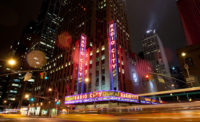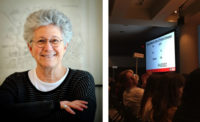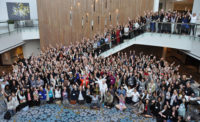Voices of Plurality Flash Mob Gathers at 2018 AIA Conference

Organizers and attendees of the flash mob at the 2018 AIA Conference surround Beverly Willis (seated).
Photo © Architectural Record

Organizers of the flash mob addressed the crowd from a small podium outside the Javits Center.

Architects Gisue Hariri and Mojgan Hariri of Hariri & Hariri displayed signs at the flash mob.
Photo © Architectural Record

Flash mob organizers Pascale Sablan, Rosa Sheng, A.L. Hu, Julia Murphy, and Caroline James
Photo © Architectural Record

Some 150 people attended the flash mob on Friday, June 22, during the 2018 AIA Conference.
Photo © Architectural Record





In the middle of the packed schedule at the 2018 AIA Conference on Architecture, just around lunchtime on Friday, a flash mob emerged on the sidewalk outside New York’s Jacob K. Javits Convention Center. The crowd was led by a group calling themselves Voices of Plurality, represented by A.L. Hu; Julia Murphy, AIA; Caroline James; Pascale Sablan, AIA; Rosa Sheng, FAIA; Roberta Washington, FAIA; and Beverly Willis, FAIA.
Armed with handheld paper fans, a symbol of the movement, they outlined their concerns in a manifesto read by James, the event’s emcee: “Clearly, architecture has a recognition and inclusion crisis. Fortunately, we have a power team.” After the organizers addressed the crowd from a small platform, chants of “this is what feminism looks like” emerged from the group that had gathered.
The flash mob comes on the heels of a demonstration at the Venice Architecture Biennale in May, organized Voices of Women (VOW) Architects, which reportedly drew more than 100 demonstrators, including Odile Decq, Jeanne Gang, and Louise Braverman. For the New York convention—which features a range of initiatives, both official and unofficial, geared toward equity, diversity, and inclusion in the field—the flash mob’s mission had expanded to be even more intersectional, a move reflected in the shift to the Voices of Plurality name. “It’s about a collective of voices,” says Pascale Sablan, AIA, of New York firm S9, the 2018 Young Architects Award Recipient and curator of the current exhibition “Say It Loud,” which celebrates 21 architects from the African Diaspora. “I'm grateful for this platform, but I surrender it to everyone around us."
The actions in both Venice and New York were inspired by a demonstration at the Cannes Film Festival this past May, where 82 women gathered on the famous red carpeted stairs—a symbolic nod to the 82 female directors who have been featured in the festivals 76-year-history (as compared to 1,866 men). There, actor Cate Blanchett and director Agnès Varda read the group’s manifesto.
While entertainment is just one of many industries abruptly grappling with issues of internal discrimination, the Voices of Plurality flash mob’s organizers say architecture’s problem may be especially entrenched. “Everyone else is leaps and bounds ahead,” James says, which means architecture must evolve to stay relevant in the 21st century.
“I would love the leadership to hear our voices and reflect on the profession’s current strategy,” says Sablan. “It's not working. The numbers are baseline.” And Willis, who noted that she was supporting the gathering as an individual, not as a representative of her foundation, which advocates for the recognition of women’s contributions to architecture, agrees: “We’ve concluded that the pace of change is far too slow … We need to do something to draw attention to the power structure, which is AIA, and managers and heads of firms across the United States,” she says. “This [flash mob] is a way to demonstrate that women are concerned, and women aren’t happy.”
At the same time, the organizers are quick to classify these actions as celebrations of visibility and inclusion, rather than acts of protest. “We’re not angry,” James explains. “These demonstrations are meant to bring inappropriate, discriminatory behavior out of the shadows, and just say, ‘Look, all these entrenched cultural norms in architecture aren't helping anyone. They’re leading to lack of productivity.’ ” And that’s why she and her colleagues are hitting the streets: “It has to change immediately because we've lost too much talent for too long,” she says.
As architectural designer A.L. Hu put it: “This is a crucial moment of awakening.”








